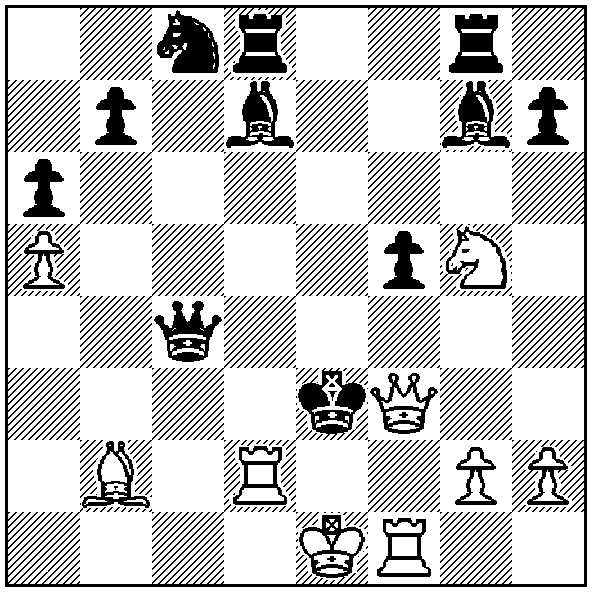|
Chess
with living pieces in the amphitheatre of Prague. At the top left is the
Black king and his retinue; at the top right is the Black queen with her
retinue.
.
Those
256 Men Played A
"Stormy" Game
.
Leopold
Hoffer
called it one of the grandest spectacles of chess with living pieces.1
The ‘game’, played at the Prague Amphitheatre on September 15th,
1895, represented the defeat of the Hungarian and Croatian King, Mathias
Carvinus, by George of Poděbrady, the Hussite King of Bohemia, in
the battle of Vilémov in 1469.
The
theatre’s field of battle was a large space of 2,304 square meters,
divided, of course, in 64 squares.2 The two armies numbered 256
men, with horses and chariots, which means that, on average, each ‘piece’
was comprised of eight men. The Chess Monthly (October 1895, page 38) wrote:
Each Pawn consisted of a group of lance-bearers in historical attire; the
Knights were mounted, the horses being splendidly comparisoned; the
Castles were in the shape of war-chariots, drawn by four horses each,
the warriors who occupied them bearing the Hungarian and Bohemian
colours; the Bishops were also on horseback, each surrounded by a group
of lance-bearers. The suits of the Kings and Queens were really gorgeous.
The
display of chess was organized during the Prague Ethnographic Exhibition.
The whole cortege paraded the exhibition grounds amid great public
interest before it entered the
Amphitheatre around 5 o’clock. The old Bohemian chorale Svatý
Václave added luster to the entrance.3
First the
armies maneuvered for some time on the chequered, theatrical battle
ground, and then the actual contest began, each
capture being a small battle of the groups representing the pieces. The
problemist Jan Dobruský composed the game that was exhibited.4 It
had the
following course:
Bohemian
Forces
- Hungarian
Forces
-
Chess
Performance
with Living Pieces
-
Amphitheatre,
Prague, September 15, 1895
-
C22
Center Game
1. e4 e5 2. d4 exd4
3. Qxd4 d6 4. Nc3 Nc6 5. Qd1 Ne5 6.
b4 c6 7. f4 Nd7 8. Bc4
Nb6 9. Bb3 Bd7
10. a4 a6 11. Qh5 g6 12. Qf3 Bg7 13. Bb2 Ne7 14. Nge2 Rg8 15.
Rd1 Qc7 16. Rd2
Rd8

17. Ng3 c5 18.
e5 dxe5 19. bxc5 Qxc5 20. Nce4 Qc6 21. fxe5
Nf5 22. a5 Nc8
23. Bd5 Qb5 24. Nxf5 gxf5 25. Bxf7+ Kxf7 26. Qh5+ Ke7 27. Ba3+
Ke6 28. Ng5+ Kxe5 29. c4 Qxc4 30. Bb2+ Kf4 31.
Rf1+ Ke3 32. Qf3, mate

Source:
Deutsches Wochenschach,
October 6, 1895, page 356.
The
Hungarian king, after being checkmated, rode up to George of Poděbrady
to offer his sword, while the orchestra played Hospodine
pomiluj ny, the old Bohemian chorale after a victorious battle.
The
originator of the idea and director of the whole affair was Franz Moucka,
secretary of the Bohemian Chess Club. The pianist Karel Pospíšil, who
was also a problemist, composed the music for the occasion. Those 256 men
were recruited from the Prague Chess Club and the Sokol Society.5
Even though the weather was bad that day, the performance was watched by 8,000 spectators through the storm and rain.
The
drawing,
based on a picture by Ateliers Adler in Prague, was made by E. Limmer.
The position did not occur in the game that was published in the Deutsches
Wochenschach. The picture resembles the position after White's 21st
move, with the exception that no knight is posted on e7 and f2 is
occupied by a pawn.
Hoffer
claimed that the Bohemian forces were White and the Hungarians Black.6
The drawing suggest the opposite. Perhaps, the first player had Black.
----------
*
The diagrams were given in the original source.
----------
Notes:
1 The
Chess Monthly, October 1895, page 38.
2 Deutsche
Schachzeitung, October 1895, page 323; Deutsches
Wochenschach, October 6, 1895, page 356.
3 Deutsches
Wochenschach, October 6, 1895, page 355.
4 Deutsche Schachzeitung, October 1895, page 323; Deutsches
Wochenschach, October 6, 1895, page 356; The
Chess Monthly, October 1895, page 38; The
British Chess Magazine, November 1895, page 468.
5 Deutsche
Schachzeitung, October 1895, page 323; Deutsches
Wochenschach, October 6, 1895, page 356.
6 The Chess Monthly, October 1895, page 38.
----------
Picture:
Chess with Living
Pieces in Prague (Illustrirte
Zeitung, November 9, 1895).
©
March 2017 Joost van Winsen. All Rights Reserved
|
